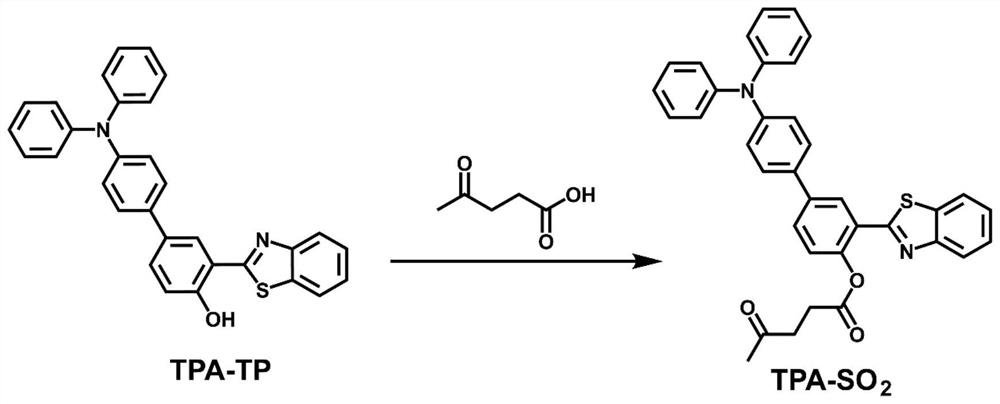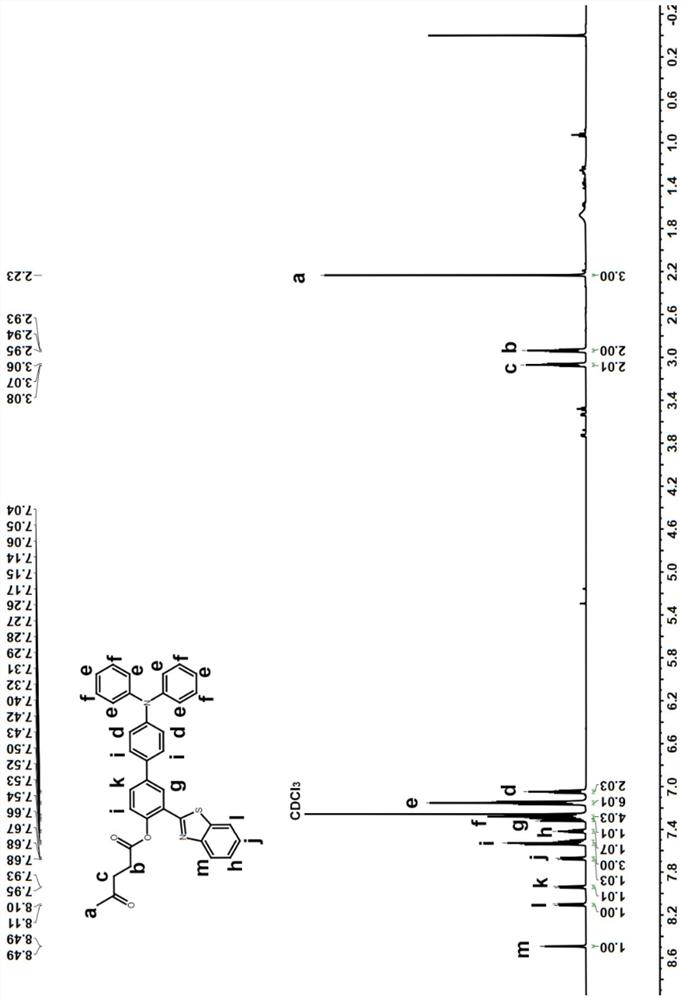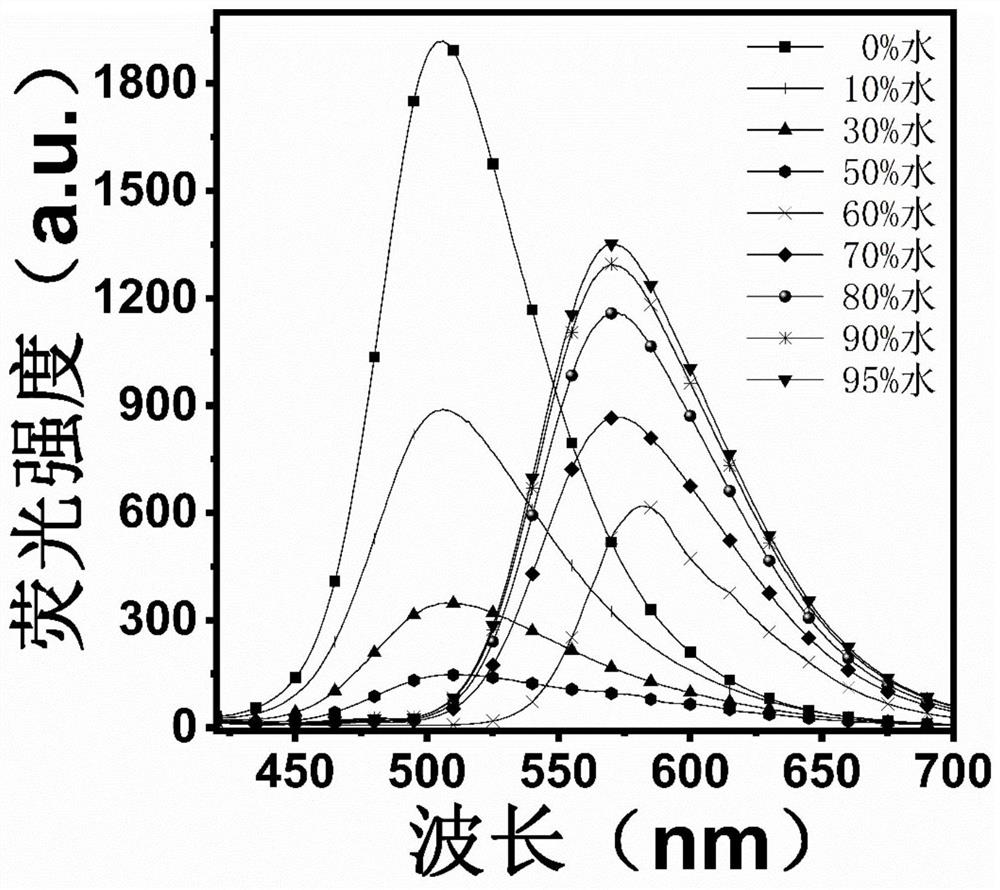Ratio type fluorescent probe and preparation method thereof, and application of ratio type fluorescent probe in sulfite ion detection
A fluorescent probe, ratio-type technology, applied in the field of analysis and detection, can solve the problems of limited wide application, difficulty in ensuring detection accuracy, fluorescence quenching, etc., and achieve the effects of improving detection accuracy, reducing spontaneous interference, and high detection sensitivity
- Summary
- Abstract
- Description
- Claims
- Application Information
AI Technical Summary
Problems solved by technology
Method used
Image
Examples
Embodiment 1
[0044] Take 423 mg of 3-(benzo[d]thiazol-2-yl)-4'-(diphenylamino)-[1,1'-biphenyl]-4-ol and 114.85 mg of levulinic acid in a single-necked flask, add 13.5 mL of dichloromethane was dissolved, the system was vacuum-filled with nitrogen and repeated three times, and stirred at room temperature for 10 minutes to obtain solution 1. Solution 2 was obtained by dissolving 445.53 mg of dicyclohexylcarbodiimide and 21.98 mg of 4-dimethylaminopyridine in 6.48 mL of dichloromethane. The solution 2 was injected into the solution 1 with a syringe, and reacted at room temperature for 15 hours. Add water and dichloromethane for extraction, take the organic phase, dry with anhydrous sodium sulfate, filter; remove the organic solvent by rotary evaporation, and purify the resulting solid by silica gel chromatography to obtain 3-(benzo[d]thiazol-2-yl)- 311 mg of 4'-(diphenylamino)-[1,1'-biphenyl]-4-yl 4-oxopentanoate (yield: 60.76%).
[0045] The product was characterized by proton nuclear magn...
Embodiment 2
[0047] Take 150 mg of 3-(benzo[d]thiazol-2-yl)-4'-(diphenylamino)-[1,1'-biphenyl]-4-ol and 37.03 mg of levulinic acid in a single-necked flask, add 1.6 mL of dichloromethane was dissolved, the system was vacuum-filled with nitrogen and repeated three times, and stirred at room temperature for 10 minutes to obtain solution 1. Solution 2 was obtained by dissolving 131.66 mg of dicyclohexylcarbodiimide and 3.90 mg of 4-dimethylaminopyridine in 1.28 mL of dichloromethane. The solution 2 was injected into the solution 1 with a syringe, and reacted at room temperature for 12 hours. Add water and dichloromethane for extraction, take the organic phase, dry with anhydrous sodium sulfate, filter; remove the organic solvent by rotary evaporation, and purify the resulting solid by silica gel chromatography to obtain 3-(benzo[d]thiazol-2-yl)- 114 mg of 4'-(diphenylamino)-[1,1'-biphenyl]-4-yl 4-oxopentanoate (yield: 63.11%). The product is characterized by proton nuclear magnetic resonanc...
Embodiment 3
[0050] Take 3-(benzo[d]thiazol-2-yl)-4'-(diphenylamino)-[1,1'-biphenyl]-4-ol 322mg and levulinic acid 83.46mg in a single-necked flask, add 6.85 mL of dichloromethane was dissolved, the system was vacuum-filled with nitrogen and repeated three times, and stirred at room temperature for 10 minutes to obtain solution 1. Solution 2 was obtained by dissolving 310.89 mg of dicyclohexylcarbodiimide and 12.55 mg of 4-dimethylaminopyridine in 3.77 mL of dichloromethane. The solution 2 was injected into the solution 1 with a syringe, and reacted at room temperature for 14 hours. Add water and dichloromethane for extraction, take the organic phase, dry with anhydrous sodium sulfate, filter; remove the organic solvent by rotary evaporation, and purify the resulting solid by silica gel chromatography to obtain 3-(benzo[d]thiazol-2-yl)- 229 mg of 4'-(diphenylamino)-[1,1'-biphenyl]-4-yl 4-oxopentanoate (yield: 58.87%). The product is characterized by proton nuclear magnetic resonance spec...
PUM
 Login to View More
Login to View More Abstract
Description
Claims
Application Information
 Login to View More
Login to View More - R&D
- Intellectual Property
- Life Sciences
- Materials
- Tech Scout
- Unparalleled Data Quality
- Higher Quality Content
- 60% Fewer Hallucinations
Browse by: Latest US Patents, China's latest patents, Technical Efficacy Thesaurus, Application Domain, Technology Topic, Popular Technical Reports.
© 2025 PatSnap. All rights reserved.Legal|Privacy policy|Modern Slavery Act Transparency Statement|Sitemap|About US| Contact US: help@patsnap.com



